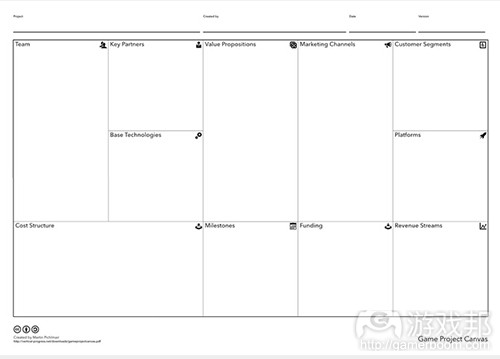如何创造你的游戏项目图表
作者:Martin Pichlmair
你们中的有些人可能已经熟悉了商业模式图,这是初创业企业可以使用的一种工具。它就是一张等待着被填满的纸。拥有计划的公司会将不同内容填进整齐划分好的表格中。该图表的理念便在于它将广泛包含所有基本内容,但同时它也存在局限性,即将迫使你在较早时候去做决策。就像你必须填写收益六,所以你需要在可下载内容,IAP或盒装产品中做出决定。即使你拥有10种收益来源,你也会意识到自己并不能只是着眼于收益流与团队或市场营销渠道便启动一项业务。商业模式图的目的是帮助你专注于某些内容并明确范围。
当使用了商业模式图,设计了一家假公司并看到了这一过程的作用时,我便决定为游戏项目创造相似的工具。这便是人们创造自己第一个专业项目的起点,当然不是针对那些经验丰富的专家们。这不仅适合独立开发者也适合AAA级工作室,但它的最初目的却是去教授那些年轻的专业人士(游戏邦注:如学生,最初的创业者,初创公司等等)去开始思考他们在某一时候必须做出的决定。该公司是面向游戏项目而非公司,这是我必须提醒你们的一点。这也是为何它同样被称为游戏项目图的原因。
如何使用游戏项目图表
很简单。你只需要填满所有表格便可。而当该项目图被填满且不存在任何矛盾内容时,你便完成了任务。完成便意味着每一个领域都被填满并且不需要添加其它内容。不存在矛盾内容则意味着任何领域都不会和其它领域产生矛盾。举个例子来说吧,如果你使用的技术是CryEngine,但你的收益流却包含3DS,你便拥有需要解决的矛盾。让我来解释每一个单独的领域吧。
团队:致力于项目中的人们以及他们所扮演的角色。如果你拥有这些角色请先为他们命名,明确团队规模。例如:“John Carmack是图像程序员。”
主要合作伙伴:发行商,市场营销代理,信息传递者。你必须将所有你将因为开发与之联系或者与游戏项目存在利害关系的人列在这里。写下公司名字就够了。但如果可以的话也请写下角色。例如:“Oculus,分销。”
基本技术:列出所有基本技术,如引擎,声音引擎,硬件平台等等。这是一个较小的领域,所以你不能详细列出所有内容。例如“Unreal Engine。”
价值主张:你的游戏的主要价值主张是什么?如果你创造的是一款行走模拟游戏,这可能是关于沉浸感,逃避主义和故事。如果你在行走模拟内容中添加了枪支,这可能便是关于残害,多人游戏和twitch streaming。你应该问问自己用户能从玩你的游戏中获得什么。例如:“专门的多人游戏。”
市场营销渠道:是YouTubers?Twitch Streamers?还是时事通讯?你应该列出任何你能与消费者交流的平台。即包括Steam Workshop社区和Gamescom。例如:“Twitch Streaming。”
消费者细分:你是否像大多数AAA级产业那样瞄准了男性硬核玩家或者你是否打算将游戏传递给大众用户?当然了你在这里填写的内容便代表着你的市场营销渠道。例如:“9至11岁的少年。”
成本架构:你将如何划分人事费用和其它成员元素?你需要多大的预算?你可以通过简单的计算去回答这些问题。例如:“整个项目的成本为140万美元。”
时间表:项目何时结束?是否有公共测试环节,什么时候进行?何时发行游戏?通常情况下你都需要在最乐观的计划基础上乘以两倍或三倍时间才能最终制作出游戏。例如:“2018年3月进行公开测试。”
经费:列出开发游戏的所有资金来源。这并不是指收益而是你在游戏发行前需要拥有的资金。如果你写下Kickstarter,你便需要拥有一个市场营销渠道,并需要反复检查你的目标用户是否使用了那一平台。可能的话,你可以为每个部分都写下对应的资金数量。例如:“IndieFund5万至8万美元。”
收益流:你是否出售游戏还是IAP?你是否提供订阅服务?像毛绒玩具和收集品也可以写在这里。虽然大多数情况下这些内容都很好填写,但这同时也能够教你去寻找其它收益流。如果你创造了一个销售预测,你便可以添加最糟糕的情况,预期的情况和最佳情况。例如:“PSN:3万美元–12万美元–30万美元。”
你可以基于各种顺序去填写这一表格,但不管怎样它们之间都是存在联系的。为了接触到特定消费群体,你会发现一些市场营销渠道比其它更合适。为了在特定平台发行游戏,你便需要选择适当的基础技术。所以我的建议便是你可以从那些已经明确的项目元素开始。可能是技术或预算。也可能是目标平台或消费者细分。当你填写了所有你已经知道的内容后你还需要填写所有的其它内容,从而确保整份表格的完整与一致。
(本文为游戏邦/gamerboom.com编译,拒绝任何不保留版权的转发,如需转载请联系:游戏邦)
The Game Project Canvas – A Project Management Tool
by Martin Pichlmair
Some of you might be familiar with the Business Model Canvas, a tool from the lean toolset for startups. The tool presents itself as a sheet of paper ready to be filled out. Different aspects of the planned company are to be filled into neatly labelled boxes. The idea of the canvas is that it covers all the bases very broadly – and given its constraints it also forces you to make decisions early in the process. You have to fill in revenue streams, for example, forcing you to make a decision between downloadable, IAP or boxed product. Even if you fit in ten sources of revenue you quickly realize that you can not kickstart a business that complex just by looking at the mismatch between your revenue streams and e.g. your team or your marketing channels. The goal of the Business Model Canvas is to help you focus and scope. And to help you to start thinking about every piece of the puzzle that a company is.
After working with the Business Model Canvas in a workshop, designing a fake company, and seeing the qualities of the process I decided to create a similar tool for game projects. It’s meant as a starting point for people doing their first professional project and not for seasoned experts. It might be suitable for indies as well as AAA studios but its original intention is to help inteaching young professionals – students, first time entrepreneurs, startups – in starting to think about the decisions they will have to make at some point. The tool is for game projects and not for companies, mind you. That’s why it’s called the Game Project Canvas.
How to work with the Game Project Canvas
It’s very simple. Just fill out all the boxes. You’re done when the canvas is complete and without any contradictions. Complete means that every field is filled out and that there is nothing to add to any field. Without contradictions means that no field contradicts another field. If your base technology, for example, is the CryEngine, but your revenue stream includes the 3DS you have a contradiction there. Let me explain every individual field.
Team: The people working on the project and what roles they will take on. Name names if you have them, define group sizes if your team is big. Example: “John Carmack, Graphics Programming”
Key Partners: Publishers, marketing agents, gatekeepers. Everyone with whom you stay in touch about the development, or who has a stake in the game project should be listed here. Company names are sufficient. Do not forget to list the role, if relevant. Example: “Oculus, Distribution”
Base Technologies: List all base technologies such as the engine, sound engine, hardware platforms and so on. This is a small field, so you can’t list every library. Example: “Unreal Engine”
Value Propositions: What are the main value propositions of your game? If you make an arty walking simulator this might be immersion, escapism, and the story. If you add guns to the walking simulator, this might be mayhem, multiplayer, and ease of twitch-streaming. Ask yourself what the user gets out of playing your game. Example: “Ad-hoc multiplayer”
Marketing Channels: YouTubers? Twitch-Streamers? Newsletters? List every single way of getting in touch with your customers. This includes the Steam Workshop community and Gamescom, if those are places you go to. Example: “Twitch Streaming”
Customer Segments: Are you targetting white male core gamers like most of the AAA industry or do you deliver a game for mass audiences? Of course what you fill out here has implications on the marketing channels. Example: “Teens 9-11″
Cost Structure: How do you split your costs between personnel costs and other cost factors? How big a budget do you need? Answer these questions by making rough calculations. Example: “$1.4M Overall Project Costs”
Milestones: When does the project end? Is there a public beta and when? When do you launch? As usual, take your optimistic plan and double or triple the time you think it takes to get the game out. Example: “March 2018, Open Beta”
Funding: List all sources of funding covering the development of the game. This is not the revenue but the money you burn before shipping. If you list Kickstarter, you have a marketing channel, too, and should double-check if your target audience is actually using that platform. If possible, add the amount of funding for each party. Example: “$50k-$80k IndieFund”
Revenue Streams: Do you sell the game or IAP? Do you offer subscriptions? Plush toys and collectibles also go in here. While in most cases, this is a pretty straight-forward box to fill out, the idea is that it also teaches you to be on the lookout for additional revenue streams. If you have made a sales projection, add the worst case, expected case, and best case. Example: “PSN, $30k-$120k-$300k”
While the boxes can be filled out in any order, there are connections between them. In order to reach a certain customer segment, some marketing channels are better suited than others. To publish on a specific platform, the right base technology has to be picked. My advice is therefor to start with those aspects of the project that are already defined. That might be a technology or the budget. Or it is the target platform and the customer segment that comes with it. After filling out everything you already know about the project, all other fields have to be filled out so that they are complete and do not contradict anything else. Go forth and write into boxes!(source:gamasutra)
http://www.gamasutra.com/blogs/MartinPichlmair/20161201/286677/The_Game_Project_Canvas__A_Project_Management_Tool.php
上一篇:有关独立游戏开发中的配音员角色
下一篇:游戏应该拥有多少游戏机制?








































 闽公网安备35020302001549号
闽公网安备35020302001549号